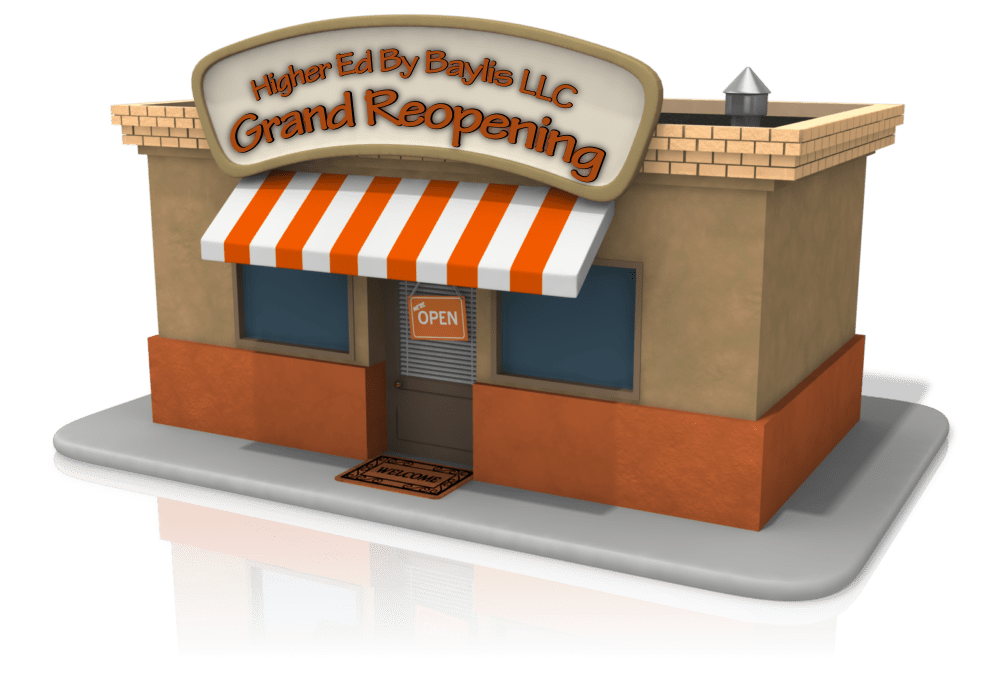As promised Higher Ed By Baylis LLC (HEBB) is officially back in business. This post is a continuation of Today is April 11! This is no April Fools’ joke. We’re Back in Business. So I begin this post with the third and fourth announcements which I had planned to make.
 The above picture of a store front with a Grand Reopening sign is only symbolic. HEBB doesn’t yet have a physical building. However, we are in the process of building a new viable, and vital business entity. I have placed emphasis on several words and concepts in the preceding sentence.The emphasis is on the word we. From January 2013, the official beginning of Higher Ed By Baylis LLC, By Baylis was the only investor and only operating consultant. My loving, loyal and responsible wife of 47 years, had access to all records of the HEBB, including the finances. I took this prudent step in case something happened to me, since twice in 2009, I entered a hospital as a member of the ABB (All But Bagged) Club. What does “All But Bagged” mean? The best description I can give probably came from the doctor that greeted Elaine when she got to the hospital when I first experienced the exploding artery, imploding tumor, and what looked liked a stroke. The doctor truly thought that I would leave the hospital in a body bag. When Elaine was introduced to the attending doctor, the doctor told her to call the family together. Elaine asked for an explanation. The doctor said, “If he survives the operation, he’ll never be the same.”
The above picture of a store front with a Grand Reopening sign is only symbolic. HEBB doesn’t yet have a physical building. However, we are in the process of building a new viable, and vital business entity. I have placed emphasis on several words and concepts in the preceding sentence.The emphasis is on the word we. From January 2013, the official beginning of Higher Ed By Baylis LLC, By Baylis was the only investor and only operating consultant. My loving, loyal and responsible wife of 47 years, had access to all records of the HEBB, including the finances. I took this prudent step in case something happened to me, since twice in 2009, I entered a hospital as a member of the ABB (All But Bagged) Club. What does “All But Bagged” mean? The best description I can give probably came from the doctor that greeted Elaine when she got to the hospital when I first experienced the exploding artery, imploding tumor, and what looked liked a stroke. The doctor truly thought that I would leave the hospital in a body bag. When Elaine was introduced to the attending doctor, the doctor told her to call the family together. Elaine asked for an explanation. The doctor said, “If he survives the operation, he’ll never be the same.”
The first significant change is that HEBB will very soon officially be a “we” It will no longer be just By Baylis. Over the past several years, as I talked with potential clients about their needs, it became obvious that the needs and the potential solution to these clients’ problems were well beyond the capabilities of one individual. To remedy this deficiency, quoting the Lennon and McCartney song title, I have called for “a little help from my friends“. I have been in discussion with a number of former colleagues and the friends that I have built up over my 40 years of experience in the world of higher education. Out of those discussions, I am pleased to announce that almost a dozen highly qualified, experienced consultants and coaches, have agreed to work with me. There are several possibilities concerning the final cooperative arrangements. In some cases, the individuals may actually join HEBB and become principals. In other situations, HEBB and some consulting/coaching practices may form an alliance and work together cooperatively.
 The above discussions are ongoing because they involve intricate legal negotiations. As soon as individual arrangements are finalized, we will make those announcements. I know I am pleased with the caliber of my current, potential partners. I am very confident that potential clients will find the collection of experts that emerges from these discussions to be a powerful force, which can easily and economically help them identify their watershed decisions and find practical and feasible answers to those organizational, world-changing questions.
The above discussions are ongoing because they involve intricate legal negotiations. As soon as individual arrangements are finalized, we will make those announcements. I know I am pleased with the caliber of my current, potential partners. I am very confident that potential clients will find the collection of experts that emerges from these discussions to be a powerful force, which can easily and economically help them identify their watershed decisions and find practical and feasible answers to those organizational, world-changing questions.
It is not yet clear what form the final entity will take when it emerges from the above mentioned discussions. I guarantee that the final entity will share the dream that lead to the founding of Higher Ed By Baylis LLC. It was a dream of resilient, welcoming, wise, listening, flexible, entrepreneurial organizations that had a strong sense of integrity, honesty, confidence, determination, and quality. For Christian colleges, this meant they had to have a central anchor of Christ. Emanating from the proposition and relational truth expressed in Christ, were cultures of learning, scholarship, engagement, hospitality, evidence, excellence and worship. A culture is a group of people who have a foundational set of values, beliefs and principles. These people generally or habitually behave in a manner consistent with their values and have developed a collective knowledge base that has grown out of their beliefs and actions. A culture is who the people are, what they know, and how they typically behave. I expressed my dream of 21st Century Christian University in the following diagram that appeared in the 2006 Winter edition of the Cornerstone magazine:

Returning to a discussion of the words emphasized in opening paragraph of this fourth announcement, some of you may be asking the question, “Don’t the terms viable and vital mean the same thing?” In one sense, they both carry the connotation of being alive. However, in another sense, they mean something very different. I am using the term viable in the sense of being capable of success or continuing effectiveness. I see HEBB as having a good probability of being successful. It can easily be very effective. I am using the term vital in its sense of having remarkable energy, liveliness, or force of personality. I foresee HEBB as a force with which to be reckoned in the coaching and consulting world. The team which we are assembling will be second to none. They will all be recognized as experts in their fields and masters of their trades. It is very important to note the plural designation on the words field and trade. HEBB will be a one-stop shop for organizations seeking help. In the educational arena, we are assembling a team that can cover the waterfront of accreditation, accountability, admissions and recruiting, advancement and fund raising, alumni relations, athletics, curriculum development and management, educational law, facility planning and management, finance, information technology, human resources and professional development, leadership development and succession, planning (including strategic, operational, tactical and master planning), regulatory compliance, and student development. HEBB will be able to work with and help any institution, whether public or private, at any educational level including primary, secondary, or higher education. Do you get the feeling of why I am excited to be back in business? Although the emphasis to this point has been with educational entitities, I foresee in the near future extending the vision of HEBB to service Christian and non-profit public service ministries, since there are many similarities in mission and operations with educational institutions.
If you are an individual who would be interested in joining HEBB as a principal or you represent a coaching/consulting practice that would be interested in collaborating in an alliance with HEBB, I would be very interested in talking with you. Please leave a comment in the reply box with your name, area(s) of expertise, an email address, a phone number, and the best time to contact you. Since I have the protocols set so that I must approve any comments before they appear, your contact information will not be shared with anyone.


The fourth and final announcement in these two blog posts relates to the HEBB website which you can find by clicking here: HEBB. For almost 18 months the website has been effectively shut down. With the reopening of Higher Ed By Baylis LLC, that’s about to change. The website is going to experience extensive remodeling to reflect the changes in HEBB.
The first change you will see is a new welcome page which will introduce people to Higher Ed By Baylis LLC, its mission, vision and core values. There will be a staff page that will introduce people to the HEBB team, a brief bio and their areas of focus. There will be a blog page with links to the blogs written by our people. There will be page of introduction to HEBB services for institutional clients. There will also be a page of introduction to services for individual and family clients. There will be a page of resources available to the general public. There will be a page of the cost of various HEBB services. These changes should be in place by the end of April.
